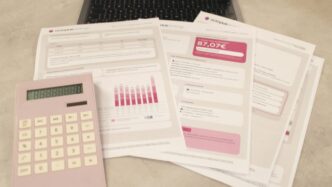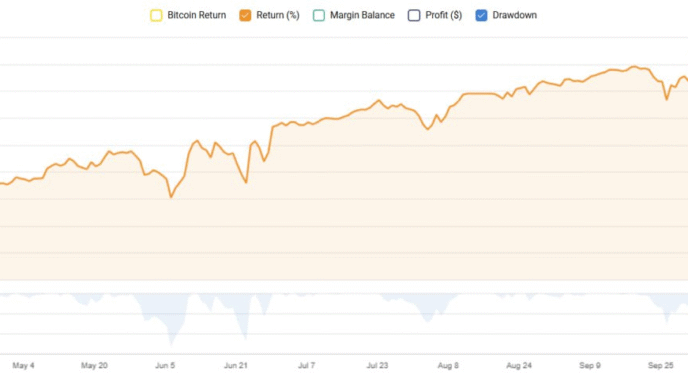Hey everyone, let’s talk about ASC 606. It’s this accounting rule that really shook things up, especially for SaaS companies. You know, the ones with all the subscriptions and recurring payments. It changed how businesses figure out when they’ve actually *earned* the money they’re getting from customers. It’s not super simple, and honestly, it can feel like a headache trying to get it all right. But, getting it right is pretty important for keeping your finances in order and making sure investors trust you. We’ll break down what ASC 606 means for asc 606 saas companies and how to handle it.
Key Takeaways
- ASC 606 is the standard for how companies record revenue from customer deals.
- For SaaS businesses, this standard changes how and when revenue is recognized, especially with subscriptions.
- The core of ASC 606 is a five-step process: identify the contract, find the promises made, figure out the price, split the price among promises, and record revenue as promises are kept.
- Getting ASC 606 right means clearer financial reports, which helps build trust with investors.
- While complex, using the right tools can make ASC 606 compliance much easier for asc 606 saas companies.
Understanding ASC 606 for SaaS Companies
So, what exactly is ASC 606, and why should SaaS companies pay attention? Basically, ASC 606 is the accounting rulebook for recognizing revenue. It was put together by the Financial Accounting Standards Board (FASB) and the International Accounting Standards Board (IASB) to make sure companies report their income in a consistent way. Before this, things were a bit all over the place, and it made comparing different companies’ financial health tough. For SaaS businesses, this standard is a big deal because the way you sell software – usually subscriptions with different features and support levels – doesn’t always fit neatly into old accounting boxes.
What is ASC 606 and Why It Matters for SaaS
At its core, ASC 606 is all about matching revenue to when you actually earn it by providing your service or product to the customer. It’s a five-step process designed to give a clearer picture of a company’s financial performance. For SaaS companies, this means looking closely at your contracts. You can’t just book all the subscription money upfront anymore. You have to figure out what you promised to deliver (like software access, support, or training) and when you deliver it. This standard helps make financial reports more comparable, which is good for investors and anyone looking at your company’s numbers.
The Core Principles of ASC 606
ASC 606 is built on a few main ideas. The big one is recognizing revenue when control of the promised goods or services is transferred to the customer. This sounds simple, but for SaaS, it gets complicated. Think about a multi-year subscription. You’re getting paid upfront, but you’re providing service over time. The standard also emphasizes identifying distinct promises within a contract. If you sell software plus implementation services, those might be separate promises, and you need to account for them separately. It also requires more detailed disclosures about your revenue contracts, giving people a better look behind the curtain.
Key Differences from Previous Standards
Compared to older rules, ASC 606 really pushes for a more principles-based approach. Instead of rigid rules, it asks you to apply judgment based on the contract’s specifics. A major shift is how it handles variable consideration, like discounts or performance bonuses. You have to estimate these amounts and include them in your transaction price only if they are probable of not having a significant reversal later. Also, the concept of ‘performance obligations’ is much more central. Previously, revenue might have been recognized based on billing cycles or contract terms. Now, it’s tied directly to the delivery of distinct goods or services. This means many SaaS companies had to rethink how they track and report revenue, especially those with complex pricing or bundled offerings.
The Five-Step Model of ASC 606

ASC 606 lays out a five-step method for figuring out how to recognize revenue from contracts. For SaaS companies, where subscriptions and blended service offers are the norm, following each step is key. This structure makes sure revenue gets recognized in a clear, consistent way—something everyone from the finance team to your investors cares about. Let’s break down each of these steps one at a time.
Identifying the Contract with a Customer
You can’t start recognizing revenue until you know there’s a real contract. This doesn’t always mean a huge legal document. Sometimes it’s just a simple agreement or sign-up with clear terms. For SaaS firms, this often includes:
- Subscription agreements (monthly, annual, etc.)
- Written or electronic confirmations
- Amendments for upgrades or downgrades
The important part is that both parties understand what they’re getting and what’s expected. For more about how to set up a solid revenue recognition plan, see this five-step strategy breakdown.
Identifying Performance Obligations
Here’s where things get a bit more involved. Each contract could include multiple promises, known as ‘performance obligations.’ These could be:
- Access to the SaaS platform itself
- Onboarding or training services
- Ongoing support or updates
If you offer something extra, like free support for a year, that might count as another obligation. Every piece should be separated, since revenue is tracked for each one.
Determining the Transaction Price
At this stage, you figure out what you’re actually getting paid. It’s not always just a flat rate. Sometimes:
- Discounts for long-term agreements come into play
- There are price adjustments if the customer upgrades
- Non-cash options (credits, barter deals) get included
You need to estimate the total price, even if some of it could change later.
Allocating the Transaction Price
With the total price set, it needs to be split among all performance obligations. This usually means:
- Assigning a standalone price to each item or service in the contract
- Using fair market value if you don’t sell some parts separately
- Adjusting if bundles or add-ons are included
A quick table example might help:
| Performance Obligation | Standalone Price | Allocated Price |
|---|---|---|
| SaaS platform (1-year) | $12,000 | $10,800 |
| Onboarding/training | $1,000 | $900 |
| Support (1-year) | $2,000 | $1,800 |
Recognizing Revenue as Obligations Are Satisfied
You only recognize revenue once you’ve done what you promised. For subscriptions, this usually means spreading revenue monthly as service gets delivered. Some points to remember:
- Revenue from onboarding is recognized right after the training is finished
- Subscription access gets recognized over each month
- Support services might be recognized as customers use them or as time passes
Sticking closely to each step matters. It’s the difference between clean books and a headache during audit season. Each piece of this model matters for SaaS companies juggling subscriptions, upgrades, and a shifting service lineup.
ASC 606 Implications for SaaS Revenue Recognition
So, what does ASC 606 actually mean for us SaaS folks? It’s not just some abstract accounting rule; it really changes how we book our revenue, especially with our subscription models. Before, some companies might have recognized revenue upfront, but ASC 606 makes us spread it out over the time we actually provide the service. This means looking closely at each contract and figuring out exactly what we’re promising to deliver and when.
Impact on Subscription Models
This is where ASC 606 really hits home for SaaS. Think about your typical monthly or annual subscription. You can’t just take all that money and say it’s earned on day one. Nope. The standard says you recognize that revenue as you deliver the service, month by month, or year by year. It’s all about matching the revenue to the actual performance obligation – which, for us, is providing access to our software and any related support.
- Revenue is recognized over the subscription term: This is the big one. If a customer pays for a year upfront, that payment is initially recorded as deferred revenue. Then, you recognize a portion of it each month as the service is provided.
- Variable consideration needs careful handling: If your pricing has usage-based components or discounts that can change, you have to estimate that variable amount and only recognize the revenue you’re reasonably sure you’ll earn.
- Contract modifications are important: If a customer upgrades or downgrades their plan mid-term, that’s a contract modification. You need to account for that change properly, which might mean adjusting how you recognize revenue for the rest of the term.
Handling Multi-Element Arrangements
Many SaaS contracts aren’t just for the software itself. You might also include things like implementation services, premium support, or training. ASC 606 requires us to identify each of these as separate performance obligations if they are distinct. Then, we have to figure out the standalone selling price for each element and allocate the total transaction price accordingly. This can get a bit tricky, especially if you don’t regularly sell these elements separately. Getting the allocation right is key to accurate revenue reporting.
Deferred Revenue Accounting Under ASC 606
Deferred revenue is a big deal in SaaS, and ASC 606 clarifies how it should be handled. That upfront payment for a future service? It sits on your balance sheet as a liability until you’ve earned it by providing the service. The standard provides a clear framework for managing these balances, ensuring that your financial statements accurately reflect your obligations to customers. This is important for understanding your true financial position and for investor confidence.
Here’s a quick look at how it generally works:
- Receive Payment: Customer pays for a 12-month subscription upfront.
- Record Deferred Revenue: The full payment is recorded as a liability (Deferred Revenue).
- Recognize Revenue Monthly: Each month, a portion of the deferred revenue is moved to earned revenue on the income statement, reflecting the service provided that month.
This approach provides a more accurate picture of your company’s financial performance over time, aligning revenue with the actual delivery of value to your customers.
Challenges and Considerations for ASC 606 Compliance

Complex Contract Terms and Variable Pricing
So, ASC 606 is all about recognizing revenue when you earn it, right? Well, for SaaS companies, contracts can get pretty wild. You’ve got subscriptions, sure, but then there are add-ons, usage-based fees, discounts that change over time, and sometimes even performance bonuses. Trying to figure out exactly what counts as a separate ‘performance obligation’ and how much of the ‘transaction price’ applies to each one can be a real head-scratcher. It’s not always a simple case of dividing the total contract value by the number of months. You really have to dig into the specifics of each deal. For instance, if a customer pays a flat monthly fee for software access but also gets charged per API call, those are likely two different things to account for separately. And what about those early-bird discounts or multi-year deals with built-in price increases? That variable pricing makes determining the ‘transaction price’ a moving target, and you have to be super careful not to over or under-recognize revenue. It requires a lot of attention to detail and a good system to track all these moving parts.
System Adjustments and Data Management
Okay, so you’ve got your contracts sorted, but now you need to actually do the accounting. Most SaaS companies weren’t built with ASC 606 in mind from day one. This means your current accounting software or spreadsheets might not be up to the task. You might need to make some pretty significant changes to how you track customer data, contract terms, and revenue recognition events. This isn’t just a quick fix; it can involve:
- Updating your billing system to capture more granular data.
- Implementing new software or modules to handle complex revenue allocations.
- Training your finance and sales teams on the new processes.
- Establishing clear data governance policies to ensure accuracy and consistency.
Getting all your systems talking to each other and making sure the data is clean and reliable is a huge undertaking. If your data is messy, your revenue recognition will be messy too, and that’s a big problem for auditors and investors.
Ensuring Ongoing Compliance and Contract Modifications
Compliance with ASC 606 isn’t a one-and-done thing. SaaS businesses are dynamic. Contracts get modified, customers upgrade or downgrade their plans, and new services are introduced. Every time a contract changes, you essentially have to go back through the five steps of ASC 606 to see how it affects your revenue recognition. Did the modification add a new performance obligation? Did it change the transaction price? This constant churn means you need processes in place to manage contract modifications effectively. It’s easy to let things slip through the cracks, especially if sales and finance aren’t perfectly aligned. You need a system that can flag these changes and prompt the right people to re-evaluate the revenue recognition treatment. Without that, you risk falling out of compliance pretty quickly.
Benefits of ASC 606 Compliance for SaaS Businesses
Okay, so dealing with accounting rules like ASC 606 might not sound like the most exciting thing, but honestly, getting it right can actually be a pretty good deal for SaaS companies. It’s not just about ticking a box for the auditors; it really can make your business run smoother and look better to people who matter, like investors.
Enhanced Financial Transparency and Comparability
One of the biggest pluses is that ASC 606 makes your financial reports clearer. Think about it: everyone’s playing by the same rules now when it comes to recognizing revenue. This means your financial statements are easier to understand and compare with other companies, whether they’re in your niche or a totally different industry. This consistency is a big deal for anyone looking at your numbers.
Improved Investor Confidence and Credibility
When investors see that your company is following standard accounting practices, it builds trust. Accurate and consistent revenue reporting under ASC 606 reduces the perceived risk of financial mistakes and makes your company’s performance look more reliable. This can make it easier to get funding or attract new investors down the line. Nobody wants to put money into a company whose financials are a mystery.
Strategic Decision-Making and Operational Improvements
Getting your revenue recognition sorted under ASC 606 means you have a clearer picture of key business metrics. Things like your actual revenue growth, profit margins, and how much value you get from each customer over time become more defined. This better understanding helps you make smarter choices about where to focus your efforts, how to price your services, and what operational changes might be needed. It can even influence how you structure your sales contracts to better align with how you recognize revenue.
Here’s a quick look at how it helps:
- Clearer Metrics: You get a more accurate view of your financial health.
- Better Planning: Improved data leads to more effective business strategies.
- Operational Alignment: Helps sync up sales, product, and finance teams.
- Global Consistency: For companies operating internationally, it simplifies reporting across different regions.
Leveraging Technology for ASC 606 Compliance
Okay, so ASC 606. It sounds like a lot, right? Especially for SaaS companies with all those subscriptions and different service packages. But here’s the thing: technology can actually make this whole process way less painful. It’s not just about ticking boxes; it’s about making your financial reporting more accurate and, honestly, a lot easier to manage.
Automating Revenue Recognition Processes
Manually tracking every single contract, figuring out performance obligations, and then recognizing revenue piece by piece? That’s a recipe for headaches, especially as your company grows. Software designed for ASC 606 can take over a lot of that heavy lifting. Think about it: these systems can automatically identify contracts, break them down into their separate parts (those performance obligations), and figure out how much revenue belongs to each part. This automation is key to reducing errors and saving a ton of time. It means your accounting team can spend less time crunching numbers and more time actually analyzing what those numbers mean for the business.
Integrating Financial Systems
Your revenue recognition software doesn’t live in a vacuum. It needs to talk to your other systems, like your CRM and your billing software. When these systems are linked up, data flows more smoothly. Your sales team logs a new contract in the CRM, that information can automatically feed into your revenue recognition system. This connection helps make sure that what your sales team is promising matches up with what your finance team is reporting. It cuts down on manual data entry and the chances of something getting lost in translation between departments.
Real-Time Reporting and Insights
One of the biggest wins with the right technology is getting a clear picture of your revenue right now. Instead of waiting for month-end reports that might be outdated by the time you get them, these systems can give you real-time dashboards. You can see exactly how much revenue you’ve recognized, what’s deferred, and how different contract types are impacting your financials. This kind of up-to-the-minute information is gold for making smart business decisions. You can spot trends, understand the financial impact of new deals, and forecast more accurately. It turns compliance from a chore into a strategic advantage.
Wrapping Up ASC 606 for SaaS
So, we’ve gone through the ins and outs of ASC 606 and what it means for SaaS companies. It’s definitely a lot to take in, with all those steps and details about contracts and obligations. But think of it this way: getting this right means your financial reports will be clearer and more trustworthy. This isn’t just about following rules; it’s about making your business look solid to investors and helping you make smarter decisions down the road. While it might seem like a headache now, getting a handle on ASC 606 can actually make your business run smoother and build more confidence with everyone involved. It’s a big step, but totally doable.
Frequently Asked Questions
What exactly is ASC 606, and why should SaaS companies care about it?
ASC 606 is a set of rules for how companies should count their earnings. Think of it like a standardized way to say when money earned from selling something should be officially recorded. For SaaS companies, which often have tricky payment plans and subscriptions, it’s super important because it makes sure everyone reports their income the same way, making their financial reports clearer and more trustworthy.
How does ASC 606 change the way SaaS companies report their income?
This new rule changes when and how SaaS companies can claim the money they make. It’s especially important for contracts that might have different parts, like a software subscription plus some extra support, or deals where the price can change. It means companies have to be more careful and organized about tracking when they’ve actually done the work they promised to earn the money.
What are the five main steps companies must follow under ASC 606?
There are five key steps to follow. First, you figure out the agreement with the customer. Second, you identify all the separate things you promised to do in that agreement. Third, you decide the total price for everything. Fourth, you split that total price among all the separate promises you made. Lastly, you count the money as you complete each of those promises.
Can following ASC 606 actually help a SaaS business run better?
Yes, it really can! By making financial information more honest and easier to understand, ASC 606 helps leaders make smarter choices. It also makes investors feel more secure about trusting the company with their money. Plus, getting things right with ASC 606 can lead to smoother operations because you have a clearer picture of how your business is doing financially.
What are some of the tricky parts SaaS companies run into when trying to follow ASC 606?
It’s not always easy. Some companies struggle with complicated contract details or figuring out prices that aren’t fixed. Changing their old computer systems to handle the new rules can be a big job, and they need to keep track of everything carefully, especially if contracts change often.
What happens if a SaaS company doesn’t follow ASC 606?
If a company doesn’t play by the ASC 606 rules, their financial reports might not be accurate. This could make investors lose faith, lead to trouble with auditors, and generally hurt the company’s reputation and financial standing. It’s basically like not telling the whole truth about how the business is performing financially.














